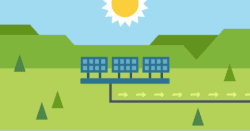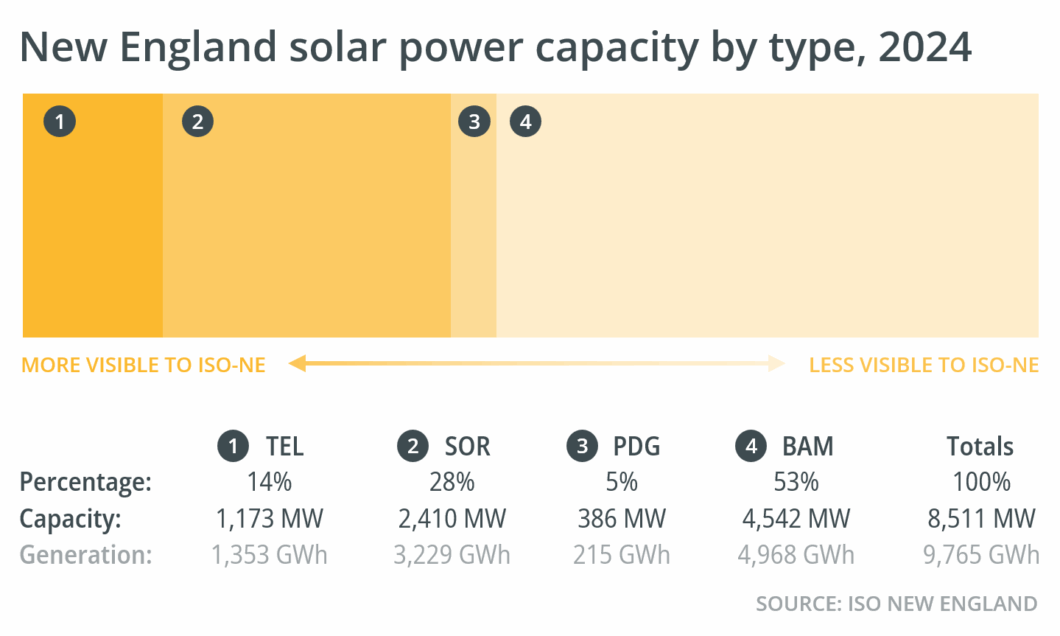Explainer: How ISO-NE tracks production from ‘behind-the-meter’ and other solar resources

Aug. 4, 2025: This article was updated to reflect 2024 data.
New England is home to a diverse and growing fleet of solar photovoltaic resources. Understanding how much electricity these resources can produce is an important part of operating the grid reliably today and planning for the power system of the future.
We estimate that, by the end of 2024, New England had about 8,500 megawatts (MW) in solar nameplate capacity. That includes everything from the largest grid-connected solar farms to the smallest arrays attached to homes. Each of these solar resources falls into one of four categories, according to how they interact with ISO New England’s control room and with the region’s wholesale electricity markets.
As shown in the graphic below, these categories are:
- Telemetered (TEL)
Solar capacity that is telemetered—meaning its output is “visible” to the ISO in real time—represents only about 14% of the total. This category is primarily made up of relatively large “utility-scale” solar farms connected to the transmission system, but also includes some solar installations connected to local distribution systems. Telemetered resources may participate in the energy and capacity markets and are dispatchable by the ISO under procedures that took effect in 2023. Real-time output from the telemetered category is reflected in the Renewables portion of the Resource Mix Chart on ISO Express and the ISO to Go mobile app. - Settlement-only resources (SOR)
Most relatively small solar farms participate as settlement-only resources. SORs are not telemetered or dispatchable, and do not provide output data to the ISO until after the day is over. SORs are paid for injecting electricity into the grid according to prices in the Real-Time Energy Market, and may also participate in the capacity market. Today, about 2,400 MW of solar capacity falls into the SOR category. Starting in November 2026, this category will include distributed energy resource aggregations (DERAs) as described in FERC Order No. 2222. - Passive distributed generation (PDG)
Nearly 400 MW of “passive” distributed generation participates in the capacity market but does not participate in the energy markets. These resources provide generation data to the ISO on a monthly basis to verify their capacity contribution to the bulk electric system. - Behind all meters (BAM)
The largest category of solar power is made up of distributed energy resources that do not participate in any wholesale market and do not provide any data to the ISO. The capacity and output of this type of solar is estimated based on data provided by distribution companies, the states, and other sources. This segment accounted for more than 4,500 MW of capacity in 2024 and is expected to grow to almost 9,000 MW over the next 10 years.

What is ‘behind-the-meter’?
“Behind-the-meter” (BTM) is a term that shows up frequently in discussions of solar power. However, the term can refer to different data collection methods that align with ISO New England’s three critical roles.

From a grid operation perspective, behind-the-meter refers to any resource that doesn’t provide real-time generation data (i.e., telemetry). In this context, BTM includes the categories of settlement-only resources (2), passive distributed generation (3), and behind all meters (4). The estimated real-time impact of these categories on the region’s demand for grid electricity is often reflected in a midday trough in the ISO Express System Load Graph and the ISO to Go Demand Chart.

From a market administration perspective, behind-the-meter stands for resources whose output serves to reduce the amount of energy withdrawn from the grid. In a markets context, BTM includes the categories of passive distributed generation (3) and behind all meters (4).

From a power system planning perspective, behind-the-meter applies only to resources that provide no data to the ISO at any time. For the purposes of planning studies and reports, only the behind all meters category (4) counts as BTM.
